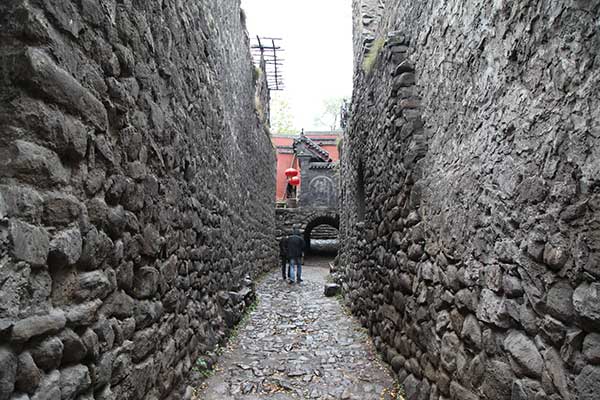An underground battleground
Updated: 2015-12-21 08:36
By Li Yang/Sun Ruisheng(China Daily)
|
||||||||
 |
|
The once-abandoned village is now a popular tourist attraction.[Photo by Sun Ruisheng/China Daily] |
Diantou resembles a beehive from outside. Inside, it's an ant farm.
A web of tunnels that stretches hundreds of kilometers connects the caves.
The altitude and gradient would make it difficult for attackers to enter the caverns. But once inside, getting from chamber to chamber is no easy task. The passageways are punctuated with shelters, peepholes and one-way doors-not to mention secret chambers with air vents used to store grain.
One passageway bores deep into a nearby mountain cave that spurts water.
While the village is pocked with wells, the mountain spring is believed to have become the primary water source when Diantou was besieged.
Villagers also used the tunnels to hide from bandits and Japanese invaders during the War of Resistance Against Japanese Aggression (1937-45).
But many became clogged during the peaceful period starting from the 1950s.
Li has cleared hundreds of meters of tunnels that connect several main cavities and installed sound-activated lights. Excavations are ongoing.
Yet while Diantou existed primarily as a military outpost, it also hosted entertainment and religious facilities.
A tumbledown theater stage faces collapsed bleachers in the shadow of two ancient locust trees in the west of the village.
A "light wall" nearby is bedecked with a candelabrum. Farmers still ignite 365 oil lanterns on the first day of the Lunar New Year and keep them burning until Feb 2 on the traditional Chinese calendar. The ritual seeks blessings for the coming year.
- Wuzhen : ancien village devient plus intelligent
- Nanyang's ancient town becomes 'painter village'
- Sanmenxia's village receives provincial honor
- A visit to 800-year-old Peitian ancient village in Fujian
- Hollowed out village in NE China and the left-behind elderly
- Remote village stays faithful to feng shui rules
- 10 execs suspected of faking pollution data
- Top 10 social media events of 2015
- Life sentences for east China child traffickers
- Shenzhen leaps to top of efficiency list in 2 yrs
- Pandas prefer choosing their own sex partners, researchers find
- Tycoons exchange views on building a cyberspace community of shared future
- Iraq holds its first beauty contest in 40 years
- Libyan factions sign UN deal to form unity government
- World's refugees and displaced exceed record 60 million
- No specific, credible terror threats against US: Obama
- UN Security Council adopts resolution to cut off Islamic State funding
- California shooters' ex-neighbor charged with supporting terrorists

 Iraq holds its first beauty contest in 40 years
Iraq holds its first beauty contest in 40 years
 Highlights at the Light of the Internet Expo
Highlights at the Light of the Internet Expo
 Finger Icons: Guess who's who
Finger Icons: Guess who's who
 Older mother who lost only child delivers another baby
Older mother who lost only child delivers another baby
 Top 10 most attractive FDI destinations in the world
Top 10 most attractive FDI destinations in the world
 Canadian college offers flying classes to legless girl
Canadian college offers flying classes to legless girl
 Fashion buyer scours the world for trendy items
Fashion buyer scours the world for trendy items
 Tycoons exchange views on building a cyberspace community of shared future
Tycoons exchange views on building a cyberspace community of shared future
Most Viewed
Editor's Picks

|

|

|

|

|

|
Today's Top News
Shooting rampage at US social services agency leaves 14 dead
Chinese bargain hunters are changing the retail game
Chinese president arrives in Turkey for G20 summit
Islamic State claims responsibility for Paris attacks
Obama, Netanyahu at White House seek to mend US-Israel ties
China, not Canada, is top US trade partner
Tu first Chinese to win Nobel Prize in Medicine
Huntsman says Sino-US relationship needs common goals
US Weekly

|

|








